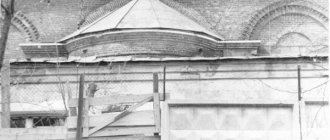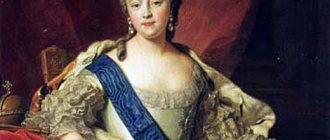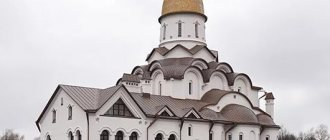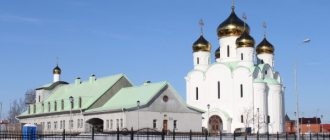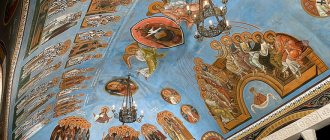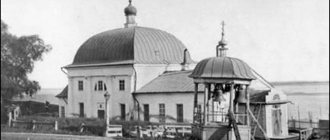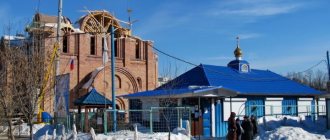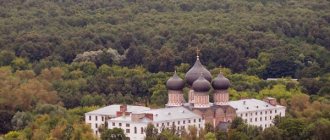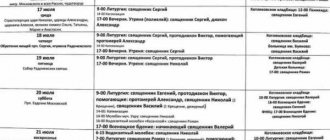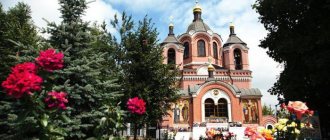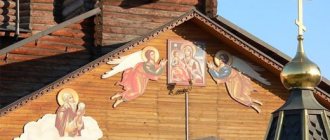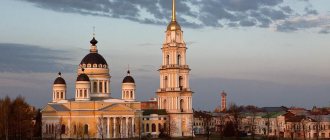The significance of the temple in the culture and history of Russia
Since the Baptism of Rus', the Orthodox Church has been the center of not only the spiritual, but also the cultural life of Russian people. In cultural terms, the Temple of Seraphim of Sarov is the personification of the universe, which, while seemingly remaining a single whole, is divided into the material and spiritual world.
Likewise, the cathedral, divided into the main and altar parts, forms a single architectural composition. Orthodox churches reflect a person’s desire for the Lord, since by subordinating all aspects of his life to him, a Christian achieves the Kingdom of God.
The cultural and historical significance of the temple is closely related to cultural symbolism.
Traditionally it has been the venue for the following events:
- seeing off soldiers to defend the Fatherland;
- announcement of government decrees;
- wedding to reign and reign of rulers;
- meetings of parish communities that play an important role in the development of the state.
In addition, for a long time Orthodox churches were educational centers. From an architectural point of view, these are the main construction projects of Orthodox settlements, in which the most advanced technologies in the field of architecture and interior design were used.
The main periods of Russian history are reflected in the temple architecture. Many sacred buildings were built as monuments dedicated to significant events in the history of the state and the ruling dynasty. They were repositories of Orthodox shrines and national treasures.
Location and how to get there
The Temple of Seraphim of Sarov is located in the north of the capital in Eastern Degunino. The territory of the capital's new religious building is located on Dubninskaya Street in property 24, one of the boundaries of which faces Zaryanova Street. The chapel can be reached using above-ground and underground public transport.
The closest public transport stops to the church are:
- Dubninskaya street 20, through which the following bus routes pass: 466, 170, 799;
- Dubninskaya street 24, where buses 677, 677k, 466, 149 stop.
The temple is being built in an area that does not yet have a metro station.
Therefore, the nearest metro platforms are:
- Seligerskaya, located on the green line, from which you can walk to the temple in 17 minutes;
- Verkhniye Lobody, also on the green line, is a 30-minute walk from the Seraphim Chapel.
History of the construction of the temple
The Church of Seraphim of Sarov in Degunino is being built with funds from members of the church community and caring residents of the parish. In this regard, construction has been going on for a long time.
The emergence of a church community
Eastern Degunino is one of the most densely populated areas of the capital. However, believing residents of the area had to visit churches in neighboring areas. In 2004, a church community appeared, which consisted of believers who wanted to build an Orthodox church within walking distance.
At first, believers gathered at the worship cross on a remote concrete area in Dubki Park. For 10 years, community members collected signatures and coordinated with the city authorities the issue of building a church-chapel nearby.
Construction of a wooden temple
By 2014, the construction site had been agreed upon and all necessary documents had been received. Fundraising has begun for the construction of a temporary building for worship. In the spring, young parishioners, in their free time from work, began building a small wooden chapel.
In early April, the frame of the building under construction was destroyed by vandals. The work had to start all over again, but despite the obstacles, the temporary chapel was completed. In September, Father Victor (Gerasimov) was appointed spiritual guardian of the community and rector of the church. On December 27, a temporary church was consecrated, which can accommodate 200 people at a time.
In January 2015, the first bishop's liturgy was held in a temporary building.
Stone Temple
In the summer of 2015, development of the stone temple project began. Six months later, the project developed by the capital’s company “ArchProject - 2” was approved. In August 2016, they began digging the foundation pit for the future temple. On November 6, the first stone was laid at its foundation, and earth from the groove of the Mother of God, located in the Diveyevo Monastery, was distributed along the perimeter of the foundation.
The construction of the sacred building is carried out in several stages:
- November 2016 - March 2022 - construction of the basement floor, start of work on its waterproofing.
- March 2022 - December - 2022 - laying external and internal walls.
- October 22, 2022 - consecration and installation of bells on the stone belfry.
- December 2022 - preparation of domes for consecration and installation on the walls.
Stages of temple construction:
According to the builders' plans, completion of construction is scheduled for 2020.
By this time, the following work must be completed:
- complete waterproofing of the basement;
- finish the interior walls of the building;
- complete work on the external surfaces of the temple;
- install iconostasis of the main and side chapels.
The completion date of the work is approximate, since the pace of construction depends on the desire of people to provide financial assistance in construction.
Temple of Boris and Gleb in Degunin
Photo: hram-bg.ruThe history of the Boris and Gleb Church in Degunin begins with... its destruction. In 1585, Polish-Livonian soldiers burned a wooden temple in the village of Degunino, which is mentioned in the source. The building we see today was built in the 60s of the 19th century, but it stands on the same spot where the first burned church was located. After the fire, it was empty for a little less than half a century: a new wooden church with the money of a local priest was built in 1633 in the name of the Apostle John, and the chapel was consecrated in the name of Boris and Gleb. The temple stood for almost two centuries. In sources from 1847-1850, it is described as a fairly strong structure, and a stone foundation is also mentioned there. And in 1863, Metropolitan Filaret recognized the wooden church as “rather dilapidated” and gave his blessing for the construction of a stone church in place of the wooden one. They planned to build mainly with money received as compensation from the state: part of the church land was needed to build the Nikolaev railway. There were also donations. For example, the owner of a brick factory, Vasily Prorekhov, donated 360 thousand bricks for construction.
Photo: hranitel.club Like many others, the Soviet government did not spare this temple: the Moscow Regional Council decided in 1941 to convert the church into an outpatient clinic. In the 60s of the last century, the building passed into the hands of the Rodina artel of disabled people, which adapted it into a knitting workshop - this is how a reinforced concrete fence and shapeless outbuildings appeared. Despite the fact that at the same time the church was officially classified as an architectural monument, the Rodina artel treated the building without reverence: the upper tiers of the bell tower were broken and the domes were removed. In the second half of the twentieth century, the factory was replaced by a garage, and only in 1991 the building was returned to the Orthodox community and restoration work began. Now the Temple of Boris and Gleb in Degunin belongs to the Moscow City Diocese of the Russian Orthodox Church.
st. Deguninskaya, 18A
View on map
+7
hram-bg.ru
The architecture of the temple and its interior decoration
To date, on the territory transferred to the church community for the construction of the temple in Degunino, there are two buildings: a temporary wooden temple and a stone frame.
Temporary Church
The Church of Seraphim of Sarov in Degunino, erected in 2014, is a wooden building with a rectangular plan, which is covered with a gable roof. It is topped with a small gilded dome mounted on a narrow high drum.
A small rectangular porch adjoins the western façade. On the other sides of the building there are two small quadrangular windows, which provide natural light to the interior. Next to the western facade, a small open belfry was erected, surrounded by an openwork forged lattice. The structure is decorated with a bulbous dome.
The inside of the church is completely decorated with wood, from which the main elements of the temple interior are made.
These include:
- iconostasis;
- icon cases and canopies for icons;
- throne;
- altar;
- analogue
The walls are decorated with numerous icons.
Of these, the most revered are the following holy images:
- Icon of St. Seraphim of Sarov , in whose honor the church-chapel was consecrated.
- List of the Seraphim-Sarov Icon of the Mother of God “Tenderness,” the original of which was the cell icon of the venerable elder.
- A revered copy of the miraculous icon of the Mother of God “Quench My Sorrows,” located in the Church of St. Nicholas the Wonderworker in Kuznetsy.
- The Mother of God icon “The Inexhaustible Chalice” , through whose prayer people prone to drunkenness receive healing.
- Hagiographic icon of the Holy Blessed Matrona of Moscow.
The main lighting is provided by three large chandeliers, which are equipped with lamps stylized as candles. Wall lamps are also sources of light. For its shape and decoration, reminiscent of the Old Testament ship built by Noah, parishioners nicknamed their church the Ark.
Plan of a stone temple
According to the project developed in 2015, the stone temple of Seraphim of Sarov is being built in accordance with the traditions adopted in Russian church architecture in the 16th-17th centuries. The main part of the temple consists of two tiers (an octagon on a quadrangle), which are topped by a high tent topped with an onion dome with an eight-pointed Orthodox cross.
The head is mounted on a narrow drum, at the base of which there are arched tabs. A zakomara belt of the same shape surrounds the base of the tent. A semicircular apse adjoins the eastern facade of the main part of the building. The southern and northern aisles are located in rectangular extensions with rounded apses.
They are topped with small drums with bulbous heads. They contain side exits from the building.
The main western entrance to the building is located in a large vestibule , adjacent to which is a wide porch. The square bell tower is adjacent to the northern façade of the narthex. It consists of two tiers separated by a classic cornice. The upper tier is covered with a hipped roof, topped with a bulbous dome, the structure of which repeats the turrets of the aisles.
On the bell tower there is a belfry of 15 bells. The lower baptismal church, service and technical premises will be located in the basement of the temple. The walls of the upper church, built from red, will be covered with facade whitewash, and the base will be finished with natural granite.
Reinforced concrete, polymer-coated roofing plates and gilding are also used in construction work. Over time, it is planned to erect an administrative building next to the main building, which will house classrooms, utility rooms and a church shop.
Temple of St. Sergius of Radonezh in Businovo
Photo: Church of St. Sergius of Radonezh (businovohram.ru) It is believed that the Church of St. Sergius of Radonezh was built in 1859 with money allocated by Prince Nikolai Obolensky and merchant Ivan Busurin. But its history is older than the building itself. The stone structure replaced the wooden one, erected in the village of Businovo in the 16th century (the first date found in sources and associated with the temple in Businovo is 1584). Initially, the temple was erected in honor of the Great Martyr St. George the Victorious, but the choice of location was determined by the legend of Sergius of Radonezh: according to legend, his path from the Trinity-Sergius Lavra (then called the Trinity Monastery) to Moscow ran through the village of Businovo. He blessed the place, which has since been assigned to the church.
Photo: Church of St. Sergius of Radonezh, 1934 (businovohram.ru) In 1623, the Church of St. George the Victorious fell into disrepair and was dismantled. For twenty years the holy place was empty, and then a wooden temple was erected there, but in the name of Sergius of Radonezh. A century later, rural peasants, using their own resources and resources, renovated the rather shabby building, but by the middle of the 19th century it too had fallen into disrepair. It was then, in 1859, that wood finally gave way to stone. Although, strictly speaking, they began to build the stone temple before the demolition of the wooden one. Only when the work was completed was the old church dismantled and a chapel erected in its place. The main altar, according to tradition, was consecrated in the name of St. Sergius, and the southern and northern aisles - in the name of the Nativity of John the Baptist and St. Nicholas the Wonderworker, respectively. When imperial power changed to Soviet power, the temple was closed, the bell tower was dismantled, the building was rebuilt and turned into a sewing workshop. Until 1990, it resembled Frankenstein’s creation - they demolished something, built on something.
Photo: the temple before restoration, 1990 (businovohram.ru) The Orthodox community tried to return the temple to its intended purpose after the turbulent Soviet period since 1988, but received refusals. Two years later, permission was received. Then restoration work began. The building returned to church status on July 18, 1991, the day of the discovery of the relics of St. Sergius of Radonezh. Now the temple in Businov belongs to the Moscow city diocese of the Russian Orthodox Church. In the Temple of St. Sergius of Radonezh there is an ark containing particles of the relics, vestments and coffin plaque of Patriarch Tikhon of Moscow and All Rus'.
st. Izhorskaya, 1 View on map
+
businovohram.ru
Social Services
The Church of Seraphim of Sarov in Degunino conducts active social service . It includes various areas and forms of interaction with the population of the parish and believers in the capital and other regions.
- Material assistance to returning Orthodox monasteries, expressed in the monthly collection of food, clothing, and personal hygiene products for the nuns of the holy monasteries in Pereyaslavl-Zalessky and Kadom.
- Age and disabilities that limit a person’s ability to move should not prevent them from visiting the temple. Therefore, the Seraphim parish operates a church social taxi service. Anyone who needs help traveling to work can call him.
- As part of the program of assistance to large and low-income parishioners, who are provided with material, spiritual and moral support.
- The temple participates in the church program to combat alcoholism and drug addiction. Within its framework, prayers are held for all those suffering from addictions, and conversations are held with them and members of their families. The clergy also provide information about the work of the church center to help parishioners suffering from these addictions.
- Participation in the “For Life” program aimed at reducing the number of abortions. Every week the rector of the temple holds conversations with pregnant women who have decided to take a desperate step. Here you can also get information about the work of the church crisis center for women who find themselves in difficult life situations.
- Strengthening the institution of family and preserving traditional Orthodox family values. As part of this work, conversations are held with parishioners about family psychology and the grammar of marriage.
The Church of Seraphim of Sarov in Degunino has a Sunday school where children of different ages gather.
In addition to social work, the temple carries out active educational activities aimed at the spiritual and patriotic development of the younger generation, familiarization with the basics of Christianity and the Church for adults.
As part of this activity, free Sunday School classes are held, which can be attended by both children and adults.
Her program of classes includes:
- study of Holy Scripture, history of Orthodoxy, temple studies;
- church choir classes;
- creative activities;
- playing guitar;
- English language.
As part of the military-patriotic direction of educational activities, conversations are held with children about the history of the country’s development from the point of view of Orthodoxy and classes in the judo section. For the older generation, a youth club operates on the basis of the temple , the activities of which are aimed at the comprehensive development of the personality of the younger generation in the bosom of the Orthodox Church.
the club organizes pilgrimage trips, visits to museums and theaters. Concerts, fairs, and tea parties are held together with parishioners.
Social ministries of the young church
The new church became a spiritual nurse for residents of the northern region of Moscow.
- The church community attracts Muscovites to collect donations, clothing and food to support the poor and monastery residents.
- Church social taxi helps disabled people and older people get to services.
- Parishioners also do not forget about large families who are constantly provided with financial assistance.
Bishop's service in the Church of St. Seraphim of Sarov - The ongoing program to combat alcoholism and drug addiction has saved not a single life.
- Participants in the “For Life” program work among women, talking about the sin of abortion and its impact on women’s health.
- Christian psychologists work with dysfunctional families.
The not yet consecrated Church of St. Seraphim became a truly people's home.
Opening hours and services at the temple
The Church of Seraphim of Sarov in Degunino is open daily. The exact schedule of services can be found in the temple itself or on its official website.
It looks like this, but on patronal and general church holidays it may change:
| Day of the week | Time | Divine service |
| Monday | 8.00 8.30 18.00 (Tuesday) |
|
| Tuesday | ||
| Wednesday | ||
| Thursday |
|
|
| Friday | ||
| Saturday |
|
|
| Sunday | 7.00 10.00 17.00 |
|
Schedule of services
DMITROVSKOE HIGHWAY VLD.66
METRO STATION (NORTH EXIT)
Temple phone numbers:
8
8.
Dear parishioners!
Please follow the requirements of Rospotrebnadzor, wear masks, use a special dispenser installed in the temple to disinfect your hands, keep a distance of 1.5 m, stand in specially marked places in the temple
SCHEDULE OF SERVICES
for MARCH 2022
| date | Holiday | Time | Divine services |
| 1, Tue | Mchch. Pamphilus the presbyter, Valens the deacon, Paul, Porphyry, Seleucia, Theodulus, Julian, Samuel, Elijah, Daniel, Jeremiah, Isaiah. St. Makaria Metropolitan Moskovsky and Kolomensky. Mchch. Persian in Martiropol | 8:00 | Liturgy |
| 18:00 | Evening service | ||
| 2, Wed | Vmch. Theodore Tyrone. Sschmch. Hermogenes, Patriarch of Moscow and All Russia, miracle worker. Right Mariamne, sisters of St. Philippa. Finding the relics of the martyr. Mines of Kallikelad. St. Theodore the Silent, Pechersk. | 8:00 | Watch. Vespers. General prayer service |
| 18:00 | Evening service | ||
| 3, Thu | St. Leo, Pope of Rome. St. Agapita Spanish, ep. Sinadsky. St. Flavian of Spain, Patriarch of Constantinople. St. Kosma Yakhromsky. St. Vladimir the Confessor. | 8:00 | Liturgy |
| 18:00 | Evening service | ||
| 4, Fri | St. Gregory Palamas, Archbishop. Solunsky. App. From the 70s of Archippus and Philemon and MC. equal to Apphias. St. Theodore of Sanaksar. Mchch. Maxima, Theodota, Hesychia, mts. Asclepiodota. | 8:00 | Watch. Vespers. Prayer for health |
| 18:00 | Evening service | ||
| 5, Sat | St. Lev, ep. Katansky. 34 Venerable Martyrs of Valaam. Sschmch. Sadoka (Shah-Dusta), bishop. Persian, and with him 128 martyrs. St. Agathon, Pope of Rome. Blgv. book Yaroslav the Wise. St. Agathon of Pechersk | 8:00 | Liturgy |
| 18:00 | All-night vigil | ||
| 6, Sun | It's a damp week. Memories of Adam's exile. Forgiveness Sunday Prayer for Great Lent St. Timothy in Symbolech. St. Eustathia, Archbishop. Antioch. St. George, bishop Amastridsky. Sschmchch. Alexander, Daniel and Gregory presbyters. Sschmch. Constantine the presbyter, Paul the deacon. Mts. Olga | 7:00 | Liturgy. General prayer service |
| 10:00 | Liturgy | ||
| 18:00 | Vespers with the rite of forgiveness | ||
| 7, Mon | Lent 1st Week of Great Lent. Finding the relics of martyrs like those in Eugene. Mchch. Mauritius and 70 warriors: Photinus, Theodore, Philip and others. Prpp. Thalassia, Limnia and Baradatha, the hermits of Syria. St. Afanasia | 8:00 | Matins. Watch. Vespers |
| 18:00 | Great Compline with reading of the Great Canon of St. Andrew of Crete | ||
| 8, Tue | Sschmch. Polycarp, bishop Smirnsky. Finding the relics of the blessed one. Matrona of Moscow. St. Alexander the monk, head of the monastery of the “Unsleeping Ones” | 8:00 | Matins. Watch. Vespers |
| 18:00 | Great Compline with reading of the Great Canon of St. Andrew of Crete | ||
| 9, Wed | St. Procopius Decapolitus, confessor of St. Erasmus of Pechersk | 8:00 | Matins. Watch. Liturgy of the Most Sacred Gifts |
| 18:00 | Great Compline with reading of the Great Canon of St. Andrew of Crete | ||
| 10 th | St. Tarasius, Patriarch of Constantinople. Sschmch. Sylvester, Archbishop. Omsk. Sschmch. Alexander the Presbyter, Primts. Mstislavs. Sschmch. Nicholas the presbyter | 8:00 | Matins. Watch. Vespers |
| 18:00 | Great Compline with reading of the Great Canon of St. Andrew of Crete | ||
| 11, Fri | St. Porfiria, Archbishop. Gazsky. Mch. Sebastian and Christodoulus. St. Sevastian Poshekhonsky.Schmch. Peter the Presbyter. Sschmch. Sergius the Presbyter | 8:00 | Liturgy. Pre-Sacred Gifts Consecration of Koliva |
| 18:00 | Evening service | ||
| 12, Sat | The first (IV) and second (452) discovery of the head of John the Baptist. St. Thalalea Syriac. St. Titus, presbyter of Pechersk. St. Titus of Pechersk, former warrior. | 8:00 | Liturgy of John Chrysostom |
| 18:00 | All-night vigil | ||
| 13, Sun | 1st week of Lent. Triumph of Orthodoxy St. John Cassian the Roman. St. Basil the Confessor. Sschmch. Arseny, Metropolitan Rostovsky. Sschmch. Nestor, bishop Magiddisky. Prpp. wives Marina and Kira. Sschmch. Proterius, Patriarch of Alexandria. | 7:00 | Liturgy of Basil the Great. General prayer service |
| 10:00 | Liturgy of Basil the Great. | ||
| 18:00 | Evening service | ||
| 14, Mon | 2nd Week of Great Lent. Prmts. Evdokia. Mchch. Nestor and Trivimia. Mts. Antonina. Mchch. Marcella and Antonia. St. Domnina of Syria. St. Martyria of Zelenetsky. Prmts. Olga. | 8:00 | Watch. Vespers. Matthew 1-7 chapters |
| 18:00 | Evening service | ||
| 15, Tue | Icon of the Mother of God, called “Sovereign”. Sschmch. Theodota, bishop Kyrineisky. St. Arsenia, bishop Tverskoy. Mch. Troadia. Mts. Euphalia. St. Agathon of Egypt. Mchch. 440 Italian | 8:00 | Watch. Vespers Matthew 8-14 |
| 18:00 | Evening service | ||
| 16, Wed | Vmch. Theodore Tyrone. Mchch. Eutropia, Cleonica and Basilisk. St. Piama maidens. St. Zenon and Zoilus. Prmts. Martha and Martyr. Michael, Volokolamsk Icon of the Mother of God | 8:00 | Liturgy of the Presanctified Gifts |
| 18:00 | Evening service | ||
| 17 th | St. Gerasim, like on the Jordan. St. Gerasim of Vologda. Blgv. book Daniil of Moscow. Mchch. Paul, his sister Juliana and with them Codratus, Acacius and Stratonice. St. Jacob the faster. | 8:00 | Watch. Vespers. 15-21 ch |
| 18, Fri | Mch. Conon of Isauria. Finding the relics of the blgv. Princes Theodore of Smolensk and his children David and Constantine, Yaroslavl miracle workers. Mch. Onisia. Mch. Konona gradar. St. Mark Postnik. St. Hesychia of the Faster | 8:00 | Liturgy of the Presanctified Gifts |
| 18:00 | Parastas | ||
| 19, Sat | Parents' Saturday. Remembrance of the Dead Mch. 42 in Ammorea, Constantine, Aetius, Theophilus, Theodore, Melissen, Callistus, Vasoya and others with them. St. Job, in the schema of Jesus, Anzersky. Prmchch. Konon and his son Konon. | 8:00 | Liturgy of John Chrysostom. Memorial service |
| 14.00 | Unction | ||
| 18:00 | All-night vigil | ||
| 20, Sun | 2nd Sunday of Lent, Luminiferous St. Gregory Palamas, Archbishop. Thessalonica Hieromartyrs who served as bishops in Chersonesus: Basil, Ephraim, Kapiton, Eugene, Etherius, Elpidia and Agathodorus. St. Pavel the Simple. St. St. Paul, bishop Prusiadsky. St. Emilian of Italy. | 7:00 | Liturgy of Basil the Great. General prayer service |
| 10:00 | Liturgy of Basil the Great. | ||
| 18.00 | Passion 1 | ||
| 21, Mon | 3rd Week of Great Lent. St. Theophylact of Spain, bishop. Nicomedia. Ap. Erma. Sschmch. Theodoret, presbyter of Antioch. Prmch. Dometia of the Persian. | 8:00 | Watch. Vespers. Mf. 22-28 |
| 18:00 | Evening service | ||
| 22, Tue | 40 martyrs who suffered in Lake Sebaste | 8:00 | Liturgy of the Presanctified Gifts |
| 18:00 | Evening service | ||
| 23, Wed | Martyr Kodrat and others like him. St. Pavel Taganrogsky. Mchch. Codratus of Nicomedia, Satorin, Rufinus, and others. St. Anastasia Patrika | 8:00 | Liturgy of the Presanctified Gifts |
| 18:00 | Evening service | ||
| 24 th | St. Sophronius, Patriarch of Jerusalem. St. Euphemia, Archbishop. Novgorod, miracle worker. | 8:00 | Watch. Vespers. Mark 1-5 ch. |
| 18:00 | Evening service | ||
| 25, Fri | St. Feofan Spanish, Sigriansky. Right Phinehas. St. Gregory Dvoeslov, Pope of Rome. St. Simeon the New Theologian. | 8:00 | Liturgy of the Presanctified Gifts |
| 18:00 | Parastas | ||
| 26, Sat | Parents' Saturday. Remembrance of the dead. Transfer of the relics of St. Nikephoros, Patriarch of Constantinople. Mch. Savina. Mchch. Africana, Publius and Terentius. Mch. Alexandra. Mts. Christina of Persia. St. Anina presbyter. | 8:00 | Liturgy of St. John Chrysostom Requiem Service |
| 14.00 | Unction | ||
| 18:00 | All-night vigil | ||
| 27, Sun | 3rd Sunday of Lent, Worship of the Cross. St. Benedict of Nursia. St. Evschimona isp., bishop. Lampsakian. Blgv. led book Rostislav-Mikhail. St. Theognosta, Met. Kyiv and all Russia. Feodorovskaya Icon of the Mother of God | 7:00 | Liturgy of V. the Great. General prayer service |
| 10:00 | Liturgy of Basil the Great. | ||
| 18.00 | Passion 2 | ||
| 28, Mon | Mch. Agapius and with him seven martyrs: Puplius, Timolaus, Romilus, two Alexanders and two Dionysius. Sschmch. Alexandra, priest in Side. Mch. Nikandra. | 8:00 | Watch. Vespers. Mark 6-10 ch. |
| 17:00 | Evening service | ||
| 29, Tue | Mch. Savina. Mch. Dads. Ap. Aristovoula, bishop Britanian (British). Sschmch. Alexander, Pope of Rome. Mch. Julian of Anazar. | 8:00 | Watch. Vespers. Mark 11-16 ch. |
| 17:00 | Evening service | ||
| 30, Wed | St. Alexy, man of God. St. Macarius, abbot of Kalyazinsky, wonderworker. Mch. Marina. Sschmch. Alexander the Presbyter. Sschmch. Victor Presbyter | 8:00 | Liturgy of the Presanctified Gifts |
| 18:00 | Evening service | ||
| 31, Thu | St. Kirill, Archbishop. Jerusalem. Mchch. Trophima and Eucarpia. St. Anya monk. Sschmch. Demetrius the Presbyter, Primts. Natalia. Fish roe is allowed at meals | 8:00 | Watch. Vespers. Luke 1-6 ch. |
| 17:00 | Evening service |
Rector of the Patriarchal Compound of the Church of St. Innocent of Moscow in Beskudnikov
Archpriest Mikhail Dudko
Interesting facts about the temple
Historical facts about the temple are of interest to people who visit it:
The altar of the Temple of Seraphim of Sarov is made of personalized bricks. As in many religious buildings, the names of benefactors and donors in Degunino are immortalized not only in prayers, but also on the bricks from which the walls of the building are erected.
The height of the stone Seraphim Church will be 39 m , which will make it the architectural dominant of the northern metropolitan area.
The temporary church, erected in 1.5 months in 2014, will be used as a Sunday school until the construction of the administrative building.
The temple is being built as part of the capital’s “200 Temples” program , the main task of which is the construction of Orthodox churches within walking distance in the residential areas of the capital. Moreover, all objects built within its framework are distinguished by a variety of architectural styles.
They reflect the stages of development of domestic church architecture.
The temporary Seraphim Church, designed for only 200 people , cannot accommodate all the Orthodox people in the area. Therefore, on Sundays and holidays, at the open windows of the building, one can observe a large crowd of Christians, thus participating in worship.
Thanks to the efforts of the parishioners of the temple, its territory is being landscaped and landscaped, organically complementing the green park area of Eastern Degunino.
Built by residents of the Eastern Degunino district with the support of the Moscow government, the Temple of Seraphim of Sarov is an example of the reviving tradition of constructing Orthodox churches. The beautiful white temple-chapel will become not only the first religious building in the area, but also its architectural landmark.
Article design: E. Chaikina
